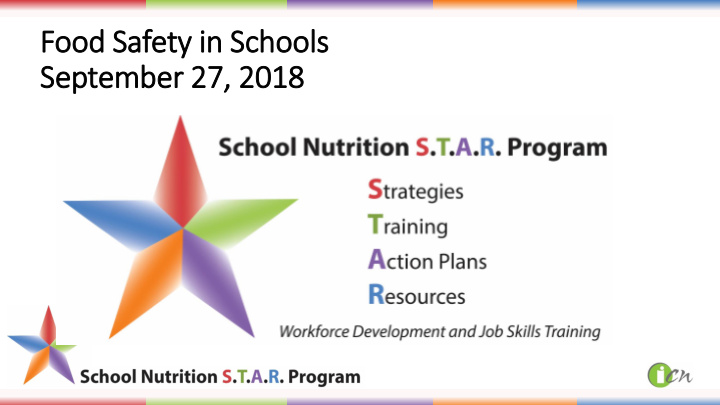



Food Safety in Schools September 27, , 2018
USDA Professional Standards Key Area: Operations USDA Professional Standard Code: • Food Safety Culture 2640
Panelists • Liz Dixon, MS, Education and Training Specialist, Institute of Child Nutrition • Tina Hanes, RDN, RN Senior Food Safety Specialist, USDA Food and Nutrition Service, Office of Food Safety • Jessica Terranova, Manager of Nutrition Services, Red Clay School District, Wilmington, Delaware • Theresa Stretch, MS, RDN, CP-FS, Education and Training Specialist ll, Institute of Child Nutrition
Learning Objective • Participants will identify strategies to promote a culture of food safety behaviors in the school community.
Food Safety
Employees
Prevent Foodborne Il Illness REPORT • Vomiting • Diarrhea • Sore throat with fever • Jaundice (yellowing of skin and eyes) • Wounds on the hands or arms • Diagnosed foodborne illness • Exposure to foodborne illness
Prevent Bare Hand Contact with Ready-to to-Eat Foods • Single-use gloves • Tongs • Spoons • Ladles • Scoops • Spoodles • Deli tissue • Package products for individual service
Environment - Keep It It Clean
Washing Dishes
Receiving Area • Cold food: 41 ° F or below • Frozen food: at or below 32 ° F
Cold Storage • Refrigerator: at or below 41 ° F • Freezer: at or below 0 ° F
Dry ry Storage Area
Preparation Area • Hold cold food at or below 41 ° F • Prepare cold food in small batches • Pre-chill shelf table foods prior to preparation • Follow standardized recipes
Avoid Contamination Type of Contamination Definition Example • Touch trash can lid while Cross contamination Transfer of bacteria or viruses • Hand-to-Food from hands, foods, or equipment preparing food • Food-to-Food • Thaw raw meat above fresh to a food • Equipment or Food Contact produce • Use a can opener on different Surfaces-to-Food foods without cleaning Chemical contamination Chemicals accidentally get in food Spray sanitizer next to uncovered pot of food Cross contact Accidental transfer of allergen into Use knife to spread peanut butter allergen-free food and then use same knife to cut a turkey sandwich without cleaning
Cooking
Serving Area
Cooling Time and Temperature Cooling Methods
Reheating • 165 ° F for 15 seconds within 2 hours
Document • Standard Operating Procedures (SOPs) • Logs
Questions?
Norovirus
www.theicn.org/foodsafety Trainings Resources Posters
Español: : theicn.org/espanol Ficha técnica Cartel Capacitación
The University of Mississippi School of Applied Sciences www.theicn.org 800-321-3054 Come follow ICN on Social Media! facebook.com/ichildnutrition @ichildnutrition instagram.com/theicn pinterest.com/theicn
Recommend
More recommend